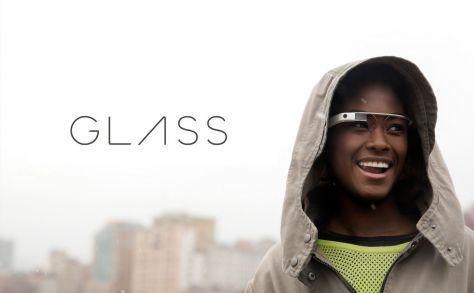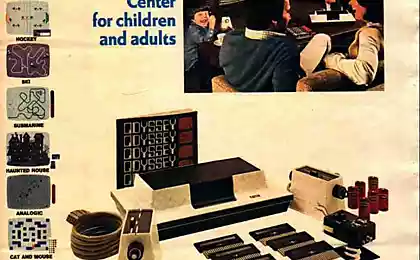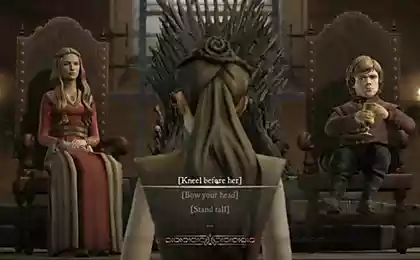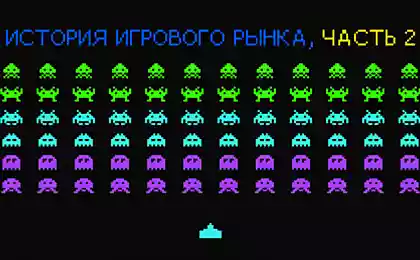1965
Brief and instructive history of video games
I am interested in different business models and decided to summarize the history of video games. From this story, you can catch some regularity in battles across multiple platforms to try to predict where this all leads in the future. The same laws apply to the music business, publishing, cinema and even a number of creative industries. I hope it will be useful.
1975-1985 gg. Rise and Fall of Atari h4>
1985-1990 gg. The era of Nintendo h4>
1990-1995 gg. Entering the market Sega h4>
1995 - 2005. The impact of the Internet market and PC. H4>
The main trends in the industry 95th: h5>
The typical life cycle of the console h5>
End generation 32/64 bit consoles. H5>
The phenomenon of online games h5>
2005 -NV. Social networks, AppStore, mobile games h4>
Conclusions. What's next? H4>
Links to sources: h4>
1975-1985 gg. Rise and Fall of Atari h4>

Back in the '70s came the first game Soup for TVs. In the 75th Atari released the first toy Pong (table tennis). In 76m sold them for about $ 200M. Somewhere in 76-77 years there was a sharp reduction in the cost of semiconductors. Atari released the Atari 2600 - the first device with a replaceable cartridge. This allowed changing cartridges to play different games. In the 77m sales industry amounted to about $ 420M.
The market has tumbled down a lot of other players, and each had its pristavki- device and cartridges for them. A curious fact - 2/3 of sales was done during the holidays and weekends.
Atari has successfully implemented a strategy of "Gillette" (give all razors and make money on the blades). They managed to sell more consoles than anyone else, and eventually became a market leader. Major sales were through large RETAIL network. It was about 1500 games for their platform.
The victory was not long. In 82-84 years people have stopped buying consoles. The market just sated - all who had already bought. Producers in warehouses and in retail has accumulated a huge amount of unsold cartridges as with games and consoles - had to sell at bargain prices. Turnover from $ 3 billion. Fell to $ 100M - Atari went bankrupt and was absorbed into Warner.
1985-1990 gg. The era of Nintendo h4>

After the collapse of the industry in 1984, all decided that video games were a passing fad. All but Nintendo, which has decided to enter this market. They made some correct conclusions:
- Altari poorly controlled range and flooded the market with low-quality games. Not having studied the demand. In short, created overproduction.
- Games were many, but they were all similar to each other and the quality is not developed, respectively, people did not have to buy the following reasons 101st game.
- And finally, they are positioned as "computerized toys" - that recession-prone and sales during the holidays.
In 1985, Nintendo has come on the market with an 8-bit consoles NES (Nintendo Entertainment System). They also adhere to the strategy of "Gillette" (low-margin hardware and high-margin game). But this is what came up with a cunning:
- They have become a monopoly of production of cartridges and cartridge tightly controlled amount in circulation. That there was no overproduction and subsequent dumping prices.
- Provide each cartridge chip, which blocked all parties-Nintendo application.
- Part of games they have developed themselves, some licensed from independent game developers.
- Is committed to diversity and to attract the best developers at the same time limit the annual production of games.
- And Nintendo developers were forced to buy back part of the cartridge forward (!). That those responsible for the quality of the final product, not only for the software.
- From beginning to launch in New York. Potestit market there. And then began an aggressive national company with the game "Super Mario».
- The focus is on children. Children urged parents "buy us a piece in which you can play Mario!". That's what I whined as a child.
In the 1990m in every 3rd house was console Nintendo (Oklo 30 million) and the company's turnover exceeded $ 3 billion.
1990-1995 gg. Entering the market Sega h4>

In 1990, the market was dominated by Nintendo. It would seem, how can someone else to enter this market? Nintendo pursued a strategy of a closed architecture, as well as IBM and Apple. In the platform, no third-party vendors. Just like Apple, they built a whole business model in full control of iron, distribution channels and third-party developers for their system.
But Nintendo missed several important factors that have given way to a new player:
- They are not very fond of independent software developers: Nintendo took himself high commission demanded be evaluated on a quarterly basis, limited edition (to avoid overproduction) and forced to buy back part of the cartridge forward.
- RETAIL just did not like Nintendo, as they worked "no return" - all costs of return went on shopping online.
- Finally, technology stepped forward and they are a very big company, is not keeping pace.
Sega in the 1989m year launched a 16-bit console called Genesis. She worked on the processor Motorolla 68000. And gave better graphics, speed and sound compared to the 8-bit Nintendo. They began to look for game developers for their consoles. And of course a few disgruntled by Nintendo (including EA) - have agreed to do for their application. Sega quickly began to build distribution channels. Many retailers have agreed to the same - to reduce dependence on Nintendo and increase its range.
But their games were not qualitatively in terms of users. Sega continued to search lyrics - in the end it was the Sonic Hedgehog (Hedgehog "Sonic»)
In 1991, during the summer vacation they took the game to the market and reduced prices. The game was for the older children and was faster and steeper than Mario. As a result, their sales soared to several hundred thousand in the 1990m, up to $ 5M in the 1992m.
Nintendo is also not standing still and released a 16-bit system (Super NES), for their 8-bit games. In the 1993m, both players held 75% of the market of video games industry with a turnover of more than $ 5, 3 billion.
1995 - 2005. The impact of the Internet market and PC. H4>

In 1993, the year the Nintendo and Sega were excellent position. But there were a few "buts»:
- Manufacturer of iron needed to adapt to the different platforms.
- It's the same with game producers capable of doing "hits". Soft began to take a greater share of the profits, while the iron gradually became cheaper. The average check average game was about $ 60, and were considered a hit selling more than 1 million. Pieces.
In 1995, several large companies plan to launch 32 and 64 bit consoles: Nintendo, Sega, Sony, Amiga.
The main trends in the industry 95th: h5>
- Industry flourished and grew steadily by 12% per year. The video generated a profit of more than $ 6 billion. That is more than Hollywood.
- Trends were such that to 2005mu, about 50% of households in the US had to have game consoles.
- The key was access to capital - without him it was impossible to start anything. The cost of production of one product were $ 200-400k, and for 32bit and even higher - about $ 2-5M.
- By the time a model project took about 15 months (9 months. - Development of the game, one month to testing, 1 month. - Approval of the platform, 4 Months. - Production of cartridges, and so on.)
- It was a very expensive marketing (mainly through RETAIL stores). On the promotion of Mortal Kombat has been spent about $ 10M.
- PC-gaming market was relatively small and held about 15% of all sales. Sega and Nintendo applications were not available on the PC. The high cost of switching between platforms. There were games on CD-ROM.
Manufacture of games very much like film production. Hollywood has long been formulated three major film business law:
1. Costs are fixed and forth. Regardless of whether it will be a blockbuster or not - money is spent on. Production - 20M, marketing - 7M, other 3M. No matter how much then will the film.
2. Law blockbuster. 4 of 10 films discourage costs. 5% of the films bring 50% of revenue.
3. No one knows anything. I mean nothing is impossible to predict.
Sales growth in the video game market, is usually associated with the release of a new generation of consoles. On average, 1 in every 5 years. Sales of consoles and games are closely related. Typically displayed a coefficient of mutual sales.
The typical life cycle of the console h5>
- A few months before the launch, the producers started to announce the release of a new console.
- Usually novelty came out at an increased price. Then about 1-2 years were price wars between competitors.
- 3-4 years of war fades, the price of the console reaches its minimum.
- On the 5th year again all had the expectation of the new console.
End generation 32/64 bit consoles. H5>
Sega and Sony launched a 32-bit consoles in the 1994m. At 1995m Nintendo introduced a 64-bit console. Sony has become the dominant player in 2000mu.
A new round started at 2000m when Sony presented PS2 - 128-bit platform. PC games market reached by 2001 m more than $ 1 billion. The main suppliers of software companies was 4 (64% market share), including EA. In contrast to the market consoles, the PC market grew much faster - every quarter there was a new processor. For example, in some 2002M computers were equipped with a 2 GHz and 512 MB of memory, while still on consoles was about 300 MHz processor. Plus PC was connected to the Internet. Plus PC market was more attractive to developers.
The phenomenon of online games h5>
Back in the 1991m appeared online games such as Doom, Duke Nukem. Next came online games. Next game portals. In the 2006m about 114 million. People play online, and about 23 million. Through the console.
Developing multiplayer games naturally more expensive than single-player. The challenge in such portals - hold interest users. To do this, constantly adding new content to the game. Many began to subscription model $ 10-20 for unlimited play. For example, the game EverQuest (from Sony) generated in a month more than $ 5M from 400 thousand. Subscribers with a margin of more than 40%. Online games require more investment ahead of the game than the usual + server + a support. Appeared online console games. Xbox launched «Xbox Live» in 2002M. Spent about $ 2 billion. - The development of this network. Planned to sell the subscription service for $ 50 per year.
At 1999m from your console Sega (Dreamcast) after several previous years of losses (due to competition from Sony and others) decided to withdraw from the market consoles and become a developer of software for the same Sony and others. + Focused on the manufacture of arcade games.
2005 -NV. Social networks, AppStore, mobile games h4>

At 2008m the video game industry reached $ 21 billion. For comparison, here is the size of related industries for the same period in the United States:
- Music market - $ 10.4 billion.
- Cinema - $ 9.5 billion.
- Books - $ 35.69 billion.
- DVD - $ 23 billion. (Purchase - $ 16 billion., Rent - $ 7 billion.)
In this case, a major producer of games such as EA (Electronic Arts) suffered losses of more than $ 1 billion. For the year. Why?
- The price of game development has grown (about 10M then rose to 25M)
- Sales of games and people's willingness to pay - to fall. (A game on average cost $ 60 and selling an average of 150 thousand units - which did not cover costs)
- There was a lot of free games for iphone
- They missed with a choice of hits. Underestimated the wii (Nintendo)
At 2008m, Apple launched the AppStore. And now any developer can create in a few days his game and place it for sale. Moreover, these games have been in the mobile phone, which is cheaper and more convenient. In EA started to cut wages. Reduced 16% of the employees. EA decided to enter the market for mobile games and games for sots.seti through the purchase of other players.
The second platform, which was to undermine the video game industry - is Facebook. Games on social networks grew explosively, gaining an audience of several million people in just a few months after launch. EA has decided to enter this market by buying Playfish for $ 400M (2nd in size under the social game developer. Network after Zinga)
Nevertheless, the video game market as of the 2013th year feels good. Here are the key figures for the world:
- Turnovers AppStore - $ 22 billion.
- Turnovers games in Facebook - $ 24 billion.
- Retail turnover (CDs in stores) - $ 20 billion.
- Video game market as a whole is estimated at $ 58 billion.
The main console on the number of sales: PlayStation (Sony) - 77 million items, Xbox (Microsoft) -77, 2 million pieces, Wii (Nintendo) - 99, 8 million. Pieces.
The main game developers in terms of turnover: Activision Blizzard - $ 4.99 billion. («Call of Duty», «World of Warcraft»), Electronic Arts - $ 3.79 billion. («Battlefield», «Madden NFL»), Take-Two Interactive Software - $ 1.22 billion. («Grand Theft Auto» and «Borderlands»), Ubisoft -1.26 billion. euros («Assassin's Creed», «Just Dance»)
By the way, recently released game GTA V, brought in revenue of $ 1 billion. Its creators just 3 days after launch - thus setting a new world record sales of video games.
Conclusions. What's next? H4>

As can be seen from this instructive story, the main battle is being played out between: users, manufacturers of iron (consoles) and game developers.
People (nick) consumed and will consume entertainment content. And try to do it for free, thereby killing the platform:
- First, buy and content, and part of the platform (Game + Console). This allows you to grow a new platform (PlayStation or Sega)
- Then only pay for the game (with the platform itself does not pay) and want a platform for free (AppStore, Facebook)
- Then people want and play for free, soglashaya only built shopping (freemium). For example, the game "Farmer" in Facebook
- Then people want to do all for free. At the same time watching a commercial. (Free Games with advertising)
- This results in poor quality of content (as good content providers have gone to where the pay) and to an abundance of annoying ads. Then the advertising model is nowhere to fall. The platform is still alive, but it has more advertising and more people are dissatisfied with it. (Facebook, Twitter, Google)
- This results in a need for a qualitatively new content. Usually this is only possible on some of the new technological platform. And then there is an opportunity for the emergence of a new platform. Such as Google Glass. And it all starts over again.
If we talk about trends, then according to many sources they are:
- Virtual Reality. She once tried to appear, but the technology was weak, now apparently it's time to reappear.
- Additional screens, control the game on TV via iPhone, etc., what did wii
- Google Glass, glasses, etc.
- OpenSource game development
- Augmented Reality
- Games in the "cloud»
in general around here should grow following the big companies.
Links to sources: h4>
A lot of information I learned from cases when I was at Stanford, especially of cases about Electronic Arts. You can buy them here somewhere for $ 7 per case.
Also thanks to Wikipedia and Reuters .
Something I picked up from your блога about the business model.
Source: habrahabr.ru/post/202004/
Flew, cheaper: as smartphones and tablets losing value at resale
3D-printer printing metal products, is available for pre-order for $ 750





























